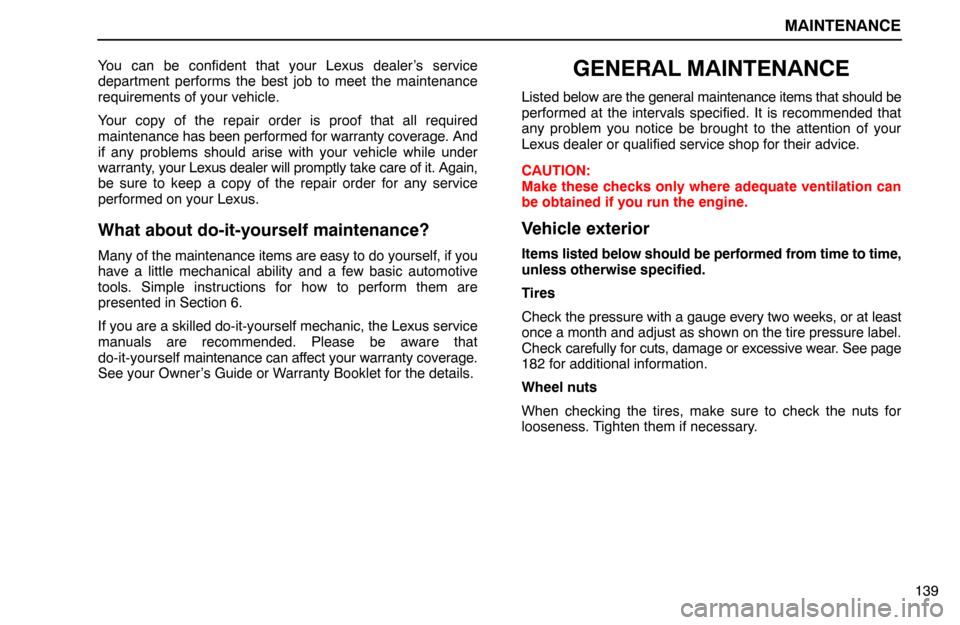Page 3 of 15

MAINTENANCE
139 You can be confident that your Lexus dealer’s service
department performs the best job to meet the maintenance
requirements of your vehicle.
Your copy of the repair order is proof that all required
maintenance has been performed for warranty coverage. And
if any problems should arise with your vehicle while under
warranty, your Lexus dealer will promptly take care of it. Again,
be sure to keep a copy of the repair order for any service
performed on your Lexus.
What about do-it-yourself maintenance?
Many of the maintenance items are easy to do yourself, if you
have a little mechanical ability and a few basic automotive
tools. Simple instructions for how to perform them are
presented in Section 6.
If you are a skilled do-it-yourself mechanic, the Lexus service
manuals are recommended. Please be aware that
do-it-yourself maintenance can affect your warranty coverage.
See your Owner’s Guide or Warranty Booklet for the details.
GENERAL MAINTENANCE
Listed below are the general maintenance items that should be
performed at the intervals specified. It is recommended that
any problem you notice be brought to the attention of your
Lexus dealer or qualified service shop for their advice.
CAUTION:
Make these checks only where adequate ventilation can
be obtained if you run the engine.
Vehicle exterior
Items listed below should be performed from time to time,
unless otherwise specified.
Tires
Check the pressure with a gauge every two weeks, or at least
once a month and adjust as shown on the tire pressure label.
Check carefully for cuts, damage or excessive wear. See page
182 for additional information.
Wheel nuts
When checking the tires, make sure to check the nuts for
looseness. Tighten them if necessary.
Page 4 of 15

MAINTENANCE
140Tire rotation
Rotate the tires every 12000 km (7500 miles). See page 183
for additional information.
Windshield wiper blades
Check for wear or cracks whenever they do not wipe clean.
Fluid leaks
Check underneath for leaking fuel, oil, water or other fluid after
the vehicle has been parked for a while. If you smell fuel fumes
or notice any leak, have the cause found and corrected
immediately.
Doors and engine hood
Check that all doors, including trunk lid, operate smoothly and
all latches lock securely. Make sure the engine hood
secondary latch still secures the hood when the primary latch
is released.
Vehicle interior
Items listed below should be checked regularly, e.g. while
performing periodic services, cleaning the vehicle, etc.
Lights
Make sure the headlights, stop lights, tail lights, turn signal
lights, and other lights are all working. Check headlight aim.Warning lights and buzzers
Check that all warning lights and buzzers function properly.
Horn
Make sure it works.
Windshield glass
Check that it is free from scratches, pits or abrasions.
Windshield wipers and washer
Check operation of the wipers and washer. Make sure the
wipers do not streak.
Windshield defroster
Check that air comes out the defroster outlet when operating
the air conditioner
Rear view mirror
Make sure it is mounted securely.
Sun visors
Make sure they move freely and are mounted securely.
Steering wheel
Check that it has the specified freeplay. See page 180 for
additional information. Be alert for changes in steering
condition, such as hard steering, excessive freeplay or strange
noise.
Page 14 of 15

MAINTENANCE
150Spark plugs
Install news plugs of the same type as originally equipped. A
qualified technician should perform this operation.
Charcoal canister
Inspect for internal damage or clogging. Clean with
compressed air or replace if necessary. A qualified technician
should perform this operation.
CHASSIS AND BODY
Brake linings and drums
Check for scoring, burning, broken parts, and excessive wear.
A qualified technician should perform this operation.
Brake pads and discs
Check the pads for excessive wear and the discs for runout
and wear. Also check for leaking fluid. A qualified technician
should perform this operation.
Brake and clutch fluids
Check for correct levels of the brake and clutch fluids. If the
level is low, add FMVSS No. 116 DOT3 or SAE J1703 brake
fluid to the brake or clutch reservoir. Change the brake and
clutch fluids as scheduled. A qualified technician should
perform those operations.Brake line pipes and hoses
Visually check for proper installation. Check for chafing,
cracks, deterioration, and any evidence of leaking. Replace
any deteriorated or damaged parts immediately. A qualified
technician should do these operations.
Steering linkage
With the vehicle stopped, check for excessive freeplay in the
steering wheel. Check the linkage for bends or damage. Check
the dust boots for deterioration, cracks, or damage. Replace
any damaged parts.
Steering gear box
Inspect the steering gear box for signs of leakage. If you
discover any leakage, have it repaired by a qualified technician
immediately.
Drive shaft boots
Inspect the drive shaft boots for clamp looseness, grease
leakage or damage. Replace any deteriorated or damaged
parts immediately. A qualified technician should perform these
operations.
Ball joints and dust covers
Check the suspension and steering linkage ball joints for
looseness or damage. Check all dust covers for deterioration
or damage. A qualified technician should perform these
operations.